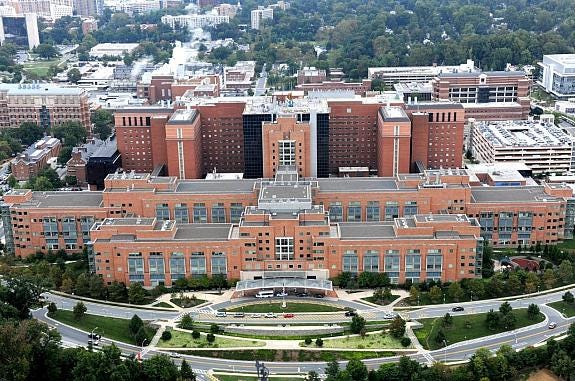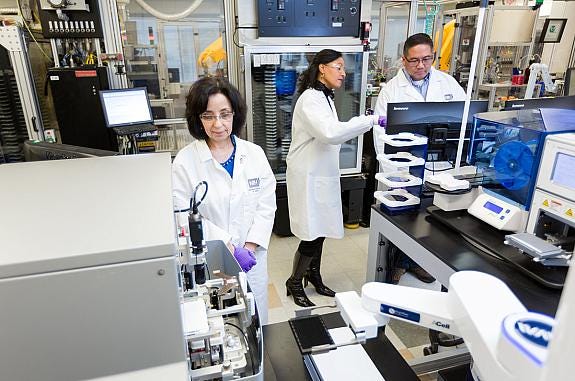What Happens if NIH Grants Are Cut?
$4 billion in medical research money is on the line.
Sponsored by
At 15 years old, Olivia Bae Wein received shocking and terrifying news. Her doctor told her that she had Stage IV non-Hodgkin lymphoma.
Instead of dreaming about the future, she was faced with the possibility she might die. “I was very angry about how unfair it was that I had to deal with this and that I might not live to go to college, get married, have kids, have a career,” she said.
Though it was rare for someone her age to get such a diagnosis, Olivia got lucky.
The National Institutes of Health (NIH) was holding a clinical trial for non-Hodgkin lymphoma, and she volunteered.
The trial was a success. Wein is now in her 50s and has been married for more than 25 years. The disease today has a 60-83% survival rate, made possible, in part, by funding from the National Institutes of Health.
NIH-funded studies have saved tens of millions of lives in the past 40 years, especially in the fields of cancer, stroke, and HIV research. But now, $4 billion in funding for research could be cut after the Trump administration issued a new memo limiting funding for NIH grants.
What are NIH grants?
NIH is the largest public funder of biomedical research in the world. Approximately 83% of NIH’s $48 billion budget goes to funding 50,000 medical research grants, money that supports more than 300,000 researchers.
Getting an NIH grant is a time-consuming and rigorous process, It can take nearly two years, and more than 80% of the researchers who apply are never approved. Applications are funneled through multiple rounds of peer and public review, followed by recommendations about which grant applications should be approved.
“Federal funding is the lifeblood of scientific research,” Joshua Akey, a genomics researcher at Princeton University says. “Without NIH grants, I cannot pay the salaries of people in my lab or for the experiments that they perform.”
Grant funding is split into two categories: direct funding and indirect funding. Direct funding goes to things like salaries for scientists or research assistants, scientific equipment, and even support costs for research subjects.
Indirect funding goes to costs associated with making the study possible, like administrative staff, building facilities, office supplies, and even janitors.
Indirect funding accounts for $9 billion of the NIH’s budget, or an average of 27-28% of every grant, according to the Trump administration. The indirect costs are paid at a negotiated rate decided between research institutions and the government, and are decided when the grant is awarded.
The distinction between direct and indirect funding is important, because it’s the indirect costs that have come under fire.
From our sponsor:
What are people reading about Trump’s new funding policy for NIH grants? It can vary greatly depending on where they get their news.
Ground News is an app and website that aggregates news from sources worldwide, so readers can compare coverage across political lines with data on each outlet’s bias, reliability, and ownership. Users can critically assess the information they consume.
Ground News is offering The Preamble readers 50% off. Click this link or visit ground.news/preamble to subscribe.
Trump goes after indirect funding
On Friday night, Dr. Dorothy Fink, acting director of NIH, published a memo that said the agency would be capping the indirect funding at 15% starting on Feb. 10. The move would cut $4 billion in funding from NIH.
The memo stated “It is accordingly vital to ensure that as many funds as possible go towards direct scientific research costs rather than administrative overhead.”
NIH’s X account also posted a graphic showing the endowments of major universities and then how much they received in indirect costs.
Elon Musk replied, “Can you believe that universities with tens of billions in endowments were siphoning off 60% of research award money for ‘overhead’? What a ripoff!”
Schools like the University of Wisconsin-Madison are major recipients of federal research funding, and they say that this cap will “significantly disrupt vital research activity and delay lifesaving discoveries and cures related to cancer, Alzheimer’s disease, diabetes, and much more.” The university spends 48% of its grant money on indirect costs.
But according to NIH, indirect costs can provide significant economic benefits to their communities.
NIH grants to the state of Wisconsin alone support more than 7,600 jobs and $1.4 billion in economic activity, according to United for Medical Research. NIH calculates that for every dollar of funding, it creates $2.46 in new business, production, and goods for the community as a whole.
But White House spokesperson Kush Desai said, "Contrary to the hysteria, redirecting billions of allocated NIH spending away from administrative bloat means there will be more money and resources available for legitimate scientific research, not less.” (It’s not clear at this time how cutting indirect funding will lead to more funding for direct costs.)
Republican Rep. Andy Harris of Maryland, who is a doctor that went to Johns Hopkins (one of the universities singled out by NIH), said “for years, the American taxpayer has paid inflated 50-60 percent ‘indirect costs’ for research in universities while nonprofits, private companies, and foundations only pay 15 percent or less.”
He went on to say the new policy is closer to what research facilities get from private foundations. According to Harris, the cuts would “actually allow more NIH funding to go directly to critical scientific research, instead of funding bloated university bureaucracies, including DEI offices.”
But researchers like Kathryn Ringland say the abruptness of the announcement has led to a budgeting crisis for research.
Ringland, who won the NIH’s Ruth L. Kirschstein National Research Service Award, pointed out that many grants go to smaller institutions, such as the University of California Santa Barbara, which received 4% of its total school budget from indirect funding. Ringland says the cap “would create a significant financial shortfall, severely impacting research capacity and institutional operations.”
The Association of American Medical Colleges said in a statement that change in funding will mean “Lights in labs nationwide will literally go out. Researchers and staff will lose their jobs. As a result, Americans will have to wait longer for cures, and our country will cede scientific breakthroughs to foreign competitors.”
University of Washington Biology Professor Carl T. Bergstrom said “For a large university, this creates a sudden and catastrophic shortfall of hundreds of millions of dollars against already budgeted funds.”
What happens next
On Monday morning, 22 state attorneys general sued the Trump administration over the policy. The states say that, “Effectively halting research to cure and treat human disease will directly impact the well-being of the Plaintiff states’ citizens.” The lawsuit also says research grants are legally binding contracts, meaning the government can’t retroactively change the rules.
A judge temporarily blocked the new policy from going into effect on Monday evening.
Republican Senator Katie Britt of Alabama, whose state’s largest employer is the NIH-funded University of Alabama, says she wants to see a careful examination of the funding. “While the administration works to achieve this goal at NIH, a smart, targeted approach is needed in order to not hinder life-saving, groundbreaking research at high-achieving institutions like those in Alabama,” she said.
But Alabama’s other Senator, Tommy Tuberville, seems fine with reducing the $1 billion in grants the University of Alabama has received in recent years. “I am 100% supportive of DOGE and Elon Musk. Elon Musk is a genius with a proven track record of making businesses more cost efficient. We should be thanking him for being willing to serve our country in this way."
Forbes calculates that red states alone are set to lose $1 billion total in NIH funding.
Republican Senator Susan Collins was more blunt than Britt, saying “I oppose the poorly conceived directive imposing an arbitrary cap on the indirect costs that are part of NIH grants and negotiated between the grant recipient and NIH.”
For now, the court has given the Trump administration until Friday to respond, and a hearing has been set for Feb 21.









One of the things we didn’t have space for in this article is something I don’t see many people talking about: we constantly complain that “big pharma” is biased and only does research that creates drugs that will profit them. So then the alternative to the drug companies funding the studies is to get government funding for it. If we want to eliminate or reduce both of these things, where does that leave us?
I am so glad I this topic came up. I think I can help people understand indirect costs (also known as Facilities and Administration costs or F&A) at research universities. To start: I am a researcher administrator at a university and my ENTIRE job is helping faculty apply for and budget for grants. Buckle up- this is long!
A few facts to understand:
1. All research institutions and universities must have a contract negotiated with a federal agency on how much F&A they can charge on grants. If you do not, the federal government already says you can only charge 10%.
2. There are different F&A rates for different locations. There is: On-Campus/ Off -Campus Adjacent ( less than 25 or 50 miles from campus)/ off campus remote (greater than 50 miles from campus). This is to account for faculty who do research in other places besides the university. DoD contracts have a different rate. There are even rates when it’s not just research but training programs or teaching.
3. You can go to your local university’ office of Sponsored Programs or office of Research and look up their negotiated rate.
4. In each of these contracts, there are also clauses about what is EXEMPT from charging indirect costs: tuition/ grad student stipends/ university fees/ fellowship costs/ major equipment over $10,000 (was $5,000) CANNOT be assessed indirect.
5. Private contractors and for Profit research facilities (like Starlink) also have negotiated F&A rates higher than 15%.
F&A/indirect go to so much more than administrative ‘bloat’. The indirect doesn’t just go to salaries and facilities. It goes to undergrad students/grad students/materials/ summer research/ and so much more. If you have a Kid in Grad school right now, these grants help them take LESS federal loans.
How is F&A charged? When you see a university or research facility say they have a 65% indirect rate for on campus research, that looks shocking. BUT that does NOT mean 65% of the funds go to the university.
Example:
*NIH puts out a call for proposals where they say we will fund the winning projects $400,000 per year over 2 years ($800,000). This is direct and indirect costs.
How much F&A can we charge? First let’s find the direct costs:
$400,000/ 1.65 (the 65%)= 242,424 direct costs can be budgeted.
$242,424 * .65 (65%)=$157,576 indirect costs
Over two years that’s $484,848 direct costs and $315,152 for a total of $800,000. Of that only 39% ($315,152/$800,00) of the funds are for F&A. Probably lower when there are costs exempt from F&A. The other 61% goes directly to research.
If we do the same math with the 15% cap. You would find that yes 87% goes directly to research. The remaining 13% (lower if there are costs exempt from F&A) however, won’t cover the actual running of the project.
Finally: there are a HOST of restrictions on what the researchers can use the funds for. And the government does regular audits each year to ensure compliance. So no: a researcher can’t just fly first class to a conference or take a vacation with the money. Direct costs can not fund items like lab maintenance (electricity and the like), food, and office supplies, which is why there is indirect. All costs have to be reconciled and reviewed. Including cost charged to indirect.
I hope this helps people understand.
*NOTE: NIH actually does things a little more complex but for the sake of the example I put it in more simple terms.